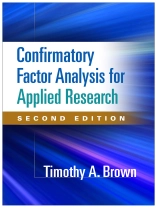With its emphasis on practical and conceptual aspects, rather than mathematics or formulas, this accessible book has established itself as the go-to resource on confirmatory factor analysis (CFA). Detailed, worked-through examples drawn from psychology, management, and sociology studies illustrate the procedures, pitfalls, and extensions of CFA methodology. The text shows how to formulate, program, and interpret CFA models using popular latent variable software packages (LISREL, Mplus, EQS, SAS/CALIS); understand the similarities and differences between CFA and exploratory factor analysis (EFA); and report results from a CFA study. It is filled with useful advice and tables that outline the procedures. The companion website (www.guilford.com/brown3-materials) offers data and program syntax files for most of the research examples, as well as links to CFA-related resources. New to This Edition *Updated throughout to incorporate important developments in latent variable modeling. *Chapter on Bayesian CFA and multilevel measurement models. *Addresses new topics (with examples): exploratory structural equation modeling, bifactor analysis, measurement invariance evaluation with categorical indicators, and a new method for scaling latent variables. *Utilizes the latest versions of major latent variable software packages.
Spis treści
l. Introduction Uses of Confirmatory Factor Analysis Psychometric Evaluation of Test Instruments Construct Validation Method Effects Measurement Invariance Evaluation Why a Book on CFA? Coverage of the Book Other Considerations Summary 2. The Common Factor Model and Exploratory Factor Analysis Overview of the Common Factor Model Procedures of EFA Factor Extraction Factor Selection Factor Rotation Factor Scores Summary 3. Introduction to CFASimilarities and Differences of EFA and CFA Common Factor Model Standardized and Unstandardized Solutions Indicator Cross-Loadings/Model Parsimony Unique Variances Model Comparison Purposes and Advantages of CFA Parameters of a CFA Model Fundamental Equations of a CFA Model CFA Model Identification Scaling the Latent Variable Statistical Identification Guidelines for Model Identification Estimation of CFA Model Parameters Illustration Descriptive Goodness-of-Fit Indices Absolute Fit Parsimony Correction Comparative Fit Guidelines for Interpreting Goodness-of-Fit Indices Summary Appendix 3.1. Communalities, Model-Implied Correlations, and Factor Correlations in EFA and CFA Appendix 3.2. Obtaining a Solution for a Just-Identified Factor Model Appendix 3.3. Hand Calculation of FML for the Figure 3.8 Path Model 4. Specification and Interpretation of CFA Models An Applied Example of a CFA Measurement Model Model Specification Substantive Justification Defining the Metric of Latent Variables Data Screening and Selection of the Fitting Function Running CFA in Different Software Programs Model Evaluation Overall Goodness of Fit Localized Areas of Strain Interpretability, Size, and Statistical Significance of the Parameter Estimates Interpretation and Calculation of CFA Model Parameter Estimates CFA Models with Single Indicators Reporting a CFA Study Summary Appendix 4.1. Model Identification Affects the Standard Errors of the Parameter Estimates Appendix 4.2. Goodness of Model Fit Does Not Ensure Meaningful Parameter Estimates Appendix 4.3. Example Report of the Two-Factor CFA Model of Neuroticism and Extraversion 5. Model Revision and Comparison Goals of Model Respecification Sources of Poor-Fitting CFA Solutions Number of Factors Indicators and Factor Loadings Correlated Errors Improper Solutions and Nonpositive Definite Matrices Intermediate Steps for Further Developing a Measurement Model for CFA EFA in the CFA Framework Exploratory SEM Model Identification Revisited Equivalent CFA Solutions Summary 6. CFA of Multitrait-Multimethod Matrices Correlated versus Random Measurement Error Revisited The Multitrait-Multimethod Matrix CFA Approaches to Analyzing the MTMM Matrix Correlated Methods Models Correlated Uniqueness Models Advantages and Disadvantages of Correlated Methods and Correlated Uniqueness Models Other CFA Parameterizations of MTMM Data Consequences of Not Modeling Method Variance and Measurement Error Summary 7. CFA with Equality Constraints, Multiple Groups, and Mean Structures Overview of Equality Constraints Equality Constraints within a Single Group Congeneric, Tau-Equivalent, and Parallel Indicators Longitudinal Measurement Invariance The Effects Coding Approach to Scaling Latent Variables CFA in Multiple Groups Overview of Multiple-Groups Solutions Multiple-Groups CFA Selected Issues in Single- and Multiple-Groups CFA Invariance Evaluation MIMIC Modeling (CFA with Covariates) Summary Appendix 7.1. Reproduction of the Observed Variance-Covariance Matrix with Tau-Equivalent Indicators of Auditory Memory 8. Other Types of CFA Models: Higher-Order Factor Analysis, Scale Reliability Evaluation, and Formative Indicators Higher-Order Factor Analysis Second-Order Factor Analysis Schmid-Leiman Transformation Bifactor Models Scale Reliability Estimation Point Estimation of Scale Reliability Standard Error and Interval Estimation of Scale Reliability Models with Formative Indicators Summary 9. Data Issues in CFA: Missing, Non-Normal, and Categorical Data CFA with Missing Data Mechanisms of Missing Data Conventional Approaches to Missing Data Recommended Strategies for Missing Data CFA with Non-Normal or Categorical Data Non-Normal, Continuous Data Categorical Data Other Potential Remedies for Indicator Non-Normality Summary 10. Statistical Power and Sample Size Overview Satorra-Saris Method Monte Carlo Approach Summary Appendix 10.1. Monte Carlo Simulation in Greater Depth: Data Generation 11. Recent Developments Involving CFA Models Bayesian CFA Bayesian Probability and Statistical Inference Priors in CFA Applied Example of Bayesian CFA Bayesian CFA: Summary Multilevel CFA Summary Appendix 11.1. Numerical Example of Bayesian Probability References Author Index Subject Index About the Author
O autorze
Timothy A. Brown, Psy D, is Professor in the Department of Psychology and Director of Research at the Center for Anxiety and Related Disorders at Boston University. He has published extensively in the areas of the classification of anxiety and mood disorders, the psychopathology and risk factors of emotional disorders, psychometrics, and applied research methods. In addition to conducting his own grant-supported research, Dr. Brown serves as a statistical investigator or consultant on numerous federally funded research projects. He has been on the editorial boards of several scientific journals, including a longstanding appointment as Associate Editor of the Journal of Abnormal Psychology.












